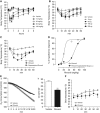Ischemic neuroprotection by TRPV1 receptor-induced hypothermia
- PMID: 22434066
- PMCID: PMC3367226
- DOI: 10.1038/jcbfm.2012.36
Ischemic neuroprotection by TRPV1 receptor-induced hypothermia
Abstract
Although treatment of stroke patients with mild hypothermia is a promising therapeutic approach, chemicals inducing prompt and safe reduction of body temperature are an unmet need. We measured the effects of the transient receptor potential vanilloid-1 (TRPV1) agonist rinvanil on thermoregulation and ischemic brain injury in mice. Intraperitoneal or intracerebroventricular injection of rinvanil induces mild hypothermia that is prevented by the receptor antagonist capsazepine. Both intraischemic and postischemic treatments provide permanent neuroprotection in animals subjected to transient middle cerebral artery occlusion (MCAo), an effect lost in mice artificially kept normothermic. Data indicate that TRPV1 receptor agonists are promising candidates for hypothermic treatment of stroke.
Figures


References
-
- Appendino G, De Petrocellis L, Trevisani M, Minassi A, Daddario N, Moriello AS, Gazzieri D, Ligresti A, Campi B, Fontana G, Pinna C, Geppetti P, Di Marzo V. Development of the first ultra-potent ‘capsaicinoid' agonist at transient receptor potential vanilloid type 1 (TRPV1) channels and its therapeutic potential. J Pharmacol Exp Ther. 2005;312:561–570. - PubMed
-
- Cozzi A, Cipriani G, Fossati S, Faraco G, Formentini L, Min W, Cortes U, Wang ZQ, Moroni F, Chiarugi A. Poly(ADP-ribose) accumulation and enhancement of postischemic brain damage in 110-kDa poly(ADP-ribose) glycohydrolase null mice. J Cereb Blood Flow Metab. 2006;26:684–695. - PubMed
-
- Diller KR, Zhu L. Hypothermia therapy for brain injury. Annu Rev Biomed Eng. 2009;11:135–162. - PubMed
-
- Eliasson MJ, Sampei K, Mandir AS, Hurn PD, Traystman RJ, Bao J, Pieper A, Wang ZQ, Dawson TM, Snyder SH, Dawson VL. Poly(ADP-ribose) polymerase gene disruption renders mice resistant to cerebral ischemia. Nat Med. 1997;3:1089–1095. - PubMed
-
- Fosgerau K, Weber UJ, Gotfredsen JW, Jayatissa M, Buus C, Kristensen NB, Vestergaard M, Teschendorf P, Schneider A, Hansen P, Raunso J, Kober L, Torp-Pedersen C, Videbaek C. Drug-induced mild therapeutic hypothermia obtained by administration of a transient receptor potential vanilloid type 1 agonist. BMC Cardiovasc Disord. 2010;10:51. - PMC - PubMed
Publication types
MeSH terms
Substances
LinkOut - more resources
Full Text Sources
Medical

